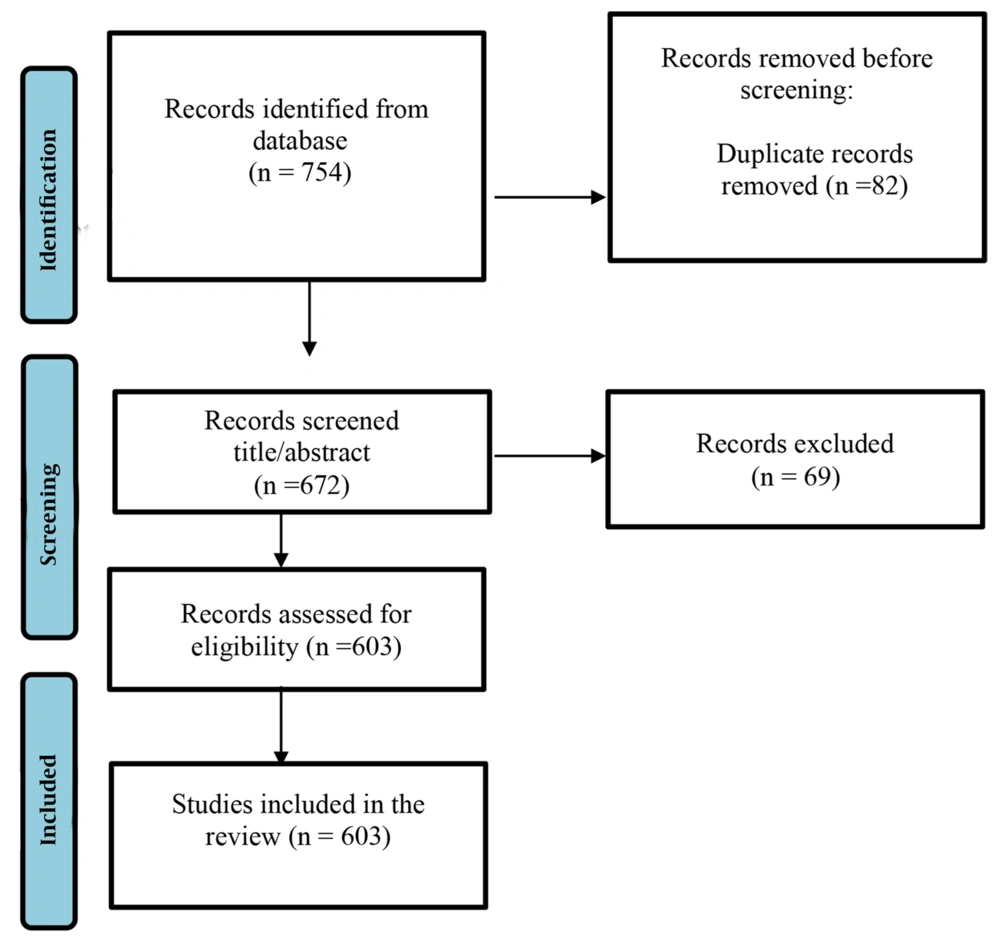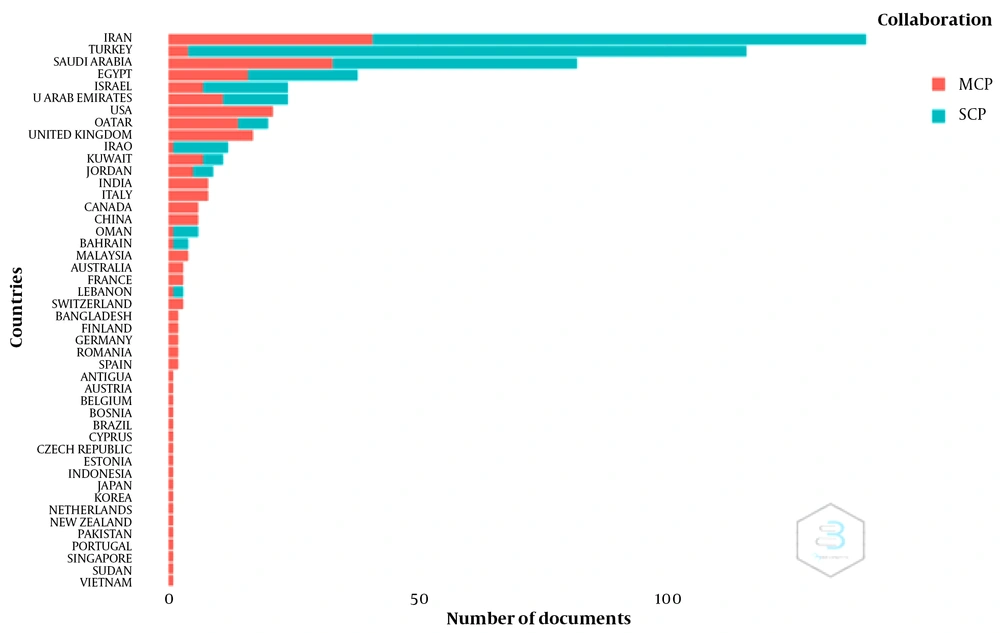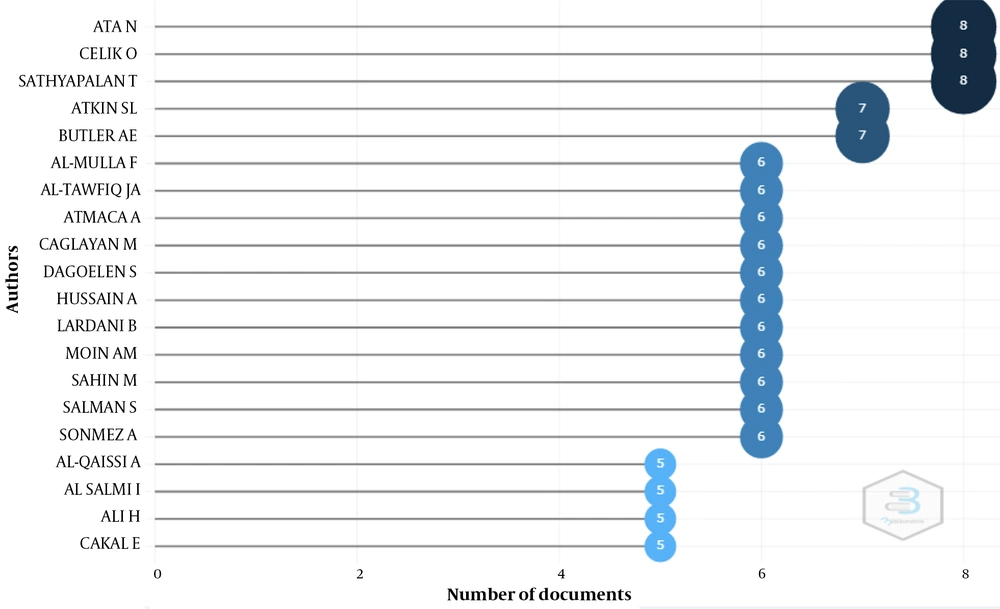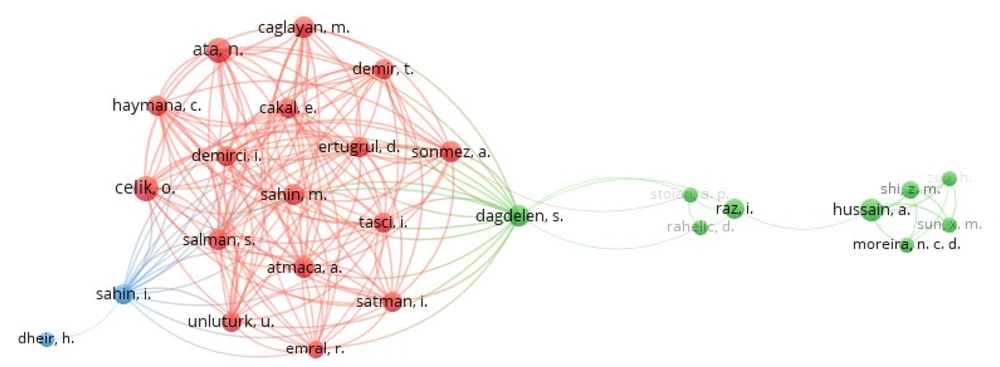1. Background
COVID-19 is the deadliest pandemic of the 21st century, caused by severe acute respiratory syndrome coronavirus 2 (SARS-CoV-2). From its beginning in December 2019 in Wuhan, China, until October 2021, it affected more than 243,572,402 cases and 4,948,434 mortalities globally (1, 2). Likewise, it caused about 16,252,932 confirmed new cases and 299,119 deaths in the Eastern Mediterranean region in the same period (1).
Patients with COVID-19 present various symptoms, from a mild fever or a slight cough to severe pneumonia and even death (3). COVID-19 affects various organs and causes complications, among which those affecting the cardiovascular system (CVD) are the most severe and fatal cases (4). Different co-morbid conditions such as old age, obesity, hypertension, diabetes, and CVD have been associated with increased COVID-19 mortality, morbidity, and worse outcomes (5, 6).
Although patients with diabetes are not at increased risk of COVID-19, they are at higher risk for its severe form, intubation, and death (7, 8). In addition, diabetes has mostly been associated with comorbidities such as obesity, CVD, and hypertension, which increase the severity of COVID-19, elevate mortality risk, and exacerbate poor prognosis (9, 10).
Scientometric studies provide a figure about characteristics of the study conditions in a specific condition such as COVID-19 worldwide or in local regions by evaluating the published articles. This is an effective method to measure the impact of publications in the scientific world (11, 12). The extension of the COVID-19 pandemic has increased the time trend of relevant scientific publications globally, including in Middle Eastern countries. Thus, scientometric studies can show a snapshot of the characteristics of the studies carried out in various fields of COVID-19 (13-17). Scientometric studies help scientists find out the gaps in knowledge and better manage current and future studies and their budgets (11).
2. Objectives
According to the effects mentioned above, this study aimed to evaluate and provide a scientometric analysis of evidence produced about diabetes and COVID-19, especially in the Middle Eastern region during the COVID-19 pandemic.
3. Methods
Initially, we searched the Web of Science database, one of the best international databases indexing high-quality scientific publications, from January 1, 2020, until September 14, 2021. We retrieved all the documents (4,957 records) and then restricted them to Middle Eastern countries, including Bahrain, Cyprus, Egypt, Iraq, Iran, Israel, Jordan, Kuwait, Lebanon, Oman, Palestine, Qatar, Saudi Arabia, Syria, Turkey, the United Arab Emirates, and Yemen (1).
The used search strategy was as follows:
TS = ((COVID-19 OR COVID19 OR SARS-CoV-2 OR coronavirus* OR (corona AND Virus*) OR 2019-nCoV OR SARS2 OR “SARS 2”)
AND
(diabetes* OR IDDM OR NIDDM OR MODY OR T1DM OR T2DM OR DM OR T1D OR T2D OR Noninsulin-Dependent OR Non-Insulin-Dependent OR Insulin-Dependent))
We categorized the results separately into 17 categories in the Endnote software based on the countries. We had 754 records after limiting the search strategy to Middle Eastern countries. There was overlap among the categories due to several studies carried out in various countries. After excluding the duplicated documents (82) and not-related studies based on title-abstract (69), 603 scientific publications (Figure 1) were analyzed to map their characteristics such as document's type, subject area, country, top journals, citation number, authors' collaboration network, Lotka's law (This law provides a possibility to assess the inequality in authors’ productivity patterns in each field and over a specified period) (3, 4), and Bradford’s law (This law helps and describes the distribution of core journals in the specified field) (5) using the VOS viewer 1.6.15 and bibliometrix R-package 4.1.1.
4. Results
Our findings indicated a time-trend in global and regional publications on COVID-19 and diabetes.
Overall, 4,957 documents were globally published on COVID-19 and diabetes in the Web of Science database during the study. The top three types were articles (n = 3,216, 65%), reviews (n = 1,054, 21%), and letters (n = 271, 5%). The top 10 organizations, sources, authors, and countries are presented in Table 1.
| Top Organizations | Top Source | Top Authors | Top Countries/ Regions | ||||
|---|---|---|---|---|---|---|---|
| University of London | 153 (3.09) | Diabetes Metabolic Syndrome Clinical Research Reviews | 266 (5.37) | Misra A | 42 (0.85) | USA | 1221 (24.63) |
| Harvard University | 123 (2.48) | Diabetes Research and Clinical Practice | 129 (2.60) | Kumar A | 27 (0.54) | India | 593 (11.96) |
| Institute National De La Sante Et De La Recherche Medicale Inserm | 105 (2.12) | Cureus | 104 (2.10) | Khunti K | 26 (0.52) | China | 513 (10.35) |
| Huazhong University of Science Technology | 99 (1.99) | Plos One | 103 (2.08) | Pranata R | 25 (0.50) | England | 494 (9.97) |
| University of California System | 98 (1.98) | Diabetes Care | 70 (1.41) | Wang J | 25 (0.50) | Italy | 457 (9.22) |
| Assistance Publique Hopitaux Paris Aphp | 86 (1.73) | Diabetes Technology Therapeutics | 61 (1.23) | Singh Ak | 23 (0.46) | Spain | 202 (4.07) |
| Harvard Medical School | 81 (1.63) | Diabetic Medicine | 59 (1.19) | Gupta R | 21 (0.42) | Brazil | 196 (3.95) |
| Wuhan University | 67 (1.35) | Journal of Clinical Medicine | 51 (1.03) | Kumar S | 21 (0.42) | France | 190 (3.83) |
| Universite De Paris | 66 (1.33) | Frontiers in Endocrinology | 41 (0.83) | Liu Y | 21 (0.42) | Iran | 179 (3.61) |
| Tehran University of Medical Sciences | 63 (1.27) | International Journal of Environmental Research and Public Health | 40 (0.81) | Vaishya R | 21 (0.42) | Germany | 172 (3.47) |
The Top Ten Organizations, Sources, Authors, and Countries Publishing Articles on COVID-19 and Diabetes a
The first ranked organization was “The University of London” (n = 153), and the top source was the “Diabetes and Metabolic Syndrome: Clinical Research and Reviews” journal (n = 266). The top authors were Misra A and Kumar A with 42 (0.85%) and 27 (0.54%) documents, respectively. The top five countries collaborating in producing these documents were the USA, followed by India, China, England, and Italy.
The primary language of these documents was English (4,806 documents), followed by Spanish (58), German (39), Russian (14), French, and Turkish (each = 12 documents).
Among the 603 documents, the primary type was articles (373, 62%), followed by reviews (134, 22%). Iran (140, 23%), Turkey (116, 19%), and Saudi Arabia (82, 14%) had the highest number of scientific outputs, respectively.
These documents were published by Middle Eastern countries or in collaboration with other countries outside the region. The top corresponding authors were from Iran (n = 140) with 99 single country publications (SCPs) and 41 multiple country publications (MCPs). SCP and MCP showed the number of publications of the corresponding authors in single or multiple countries, respectively. The figures for Turkey and Saudi Arabia were (SCP: 112, MCP: 4) and (SCP: 49, MCP: 33), respectively, as shown in Figure 2.
The most common affiliation was "Tehran University of Medical Sciences," with 168 (22%) articles, followed by "Shahid Beheshti University of Medical Sciences" with 82 (10%) articles, both from Iran. "University of Health Sciences" with 73 (9%) articles from Turkey, "King Saud University" with 53 (7%) articles from Saudi Arabia, and "Shiraz University of Medical Sciences" with 39 (0.05) articles from Iran ranked next, respectively.
In the Middle East, the total citation number was 3704, and the highest citation (925) country was Iran. The highest cited paper was a systematic review from Iran (348 citation number), published in "Archives of Academic Emergency Medicine." The second and third most cited papers (278 and 133 citation numbers) were published in the “Lancet” and “Journal of Medical Virology," respectively (Table 2).
| Author-Date | Title | Journal | TC | TC/Y |
|---|---|---|---|---|
| Emami A, et al. (2020) | Prevalence of underlying diseases in hospitalized patients with COVID-19: A systematic review and meta-analysis | Arch Acad Emerg Med | 348 | 174 |
| McGonagle D, et al. (2020) | Immune mechanisms of pulmonary intravascular coagulopathy in COVID-19 pneumonia | Lancet Rheumatol | 278 | 139 |
| Alattar R, et al. (2020) | Tocilizumab for the treatment of severe coronavirus disease 2019 | J Med Virol | 133 | 66.5 |
| Sharif-Askari NS, et al. (2020) | Airways expression of SARS-CoV-2 receptor, ACE2, and TMPRSS2 is lower in children than adults and increases with smoking and COPD | Mol Thermeth Clin D | 83 | 41.5 |
| Alsofayan YM, et al. (2020) | Clinical characteristics of COVID-19 in Saudi Arabia: A national retrospective study | J Infect Public Heal | 71 | 35.5 |
| Govindan K, et al. (2020) | A decision support system for demand management in healthcare supply chains considering the epidemic outbreaks: A case study of coronavirus disease 2019 (COVID-19) | Transport Res E-Log | 61 | 30.5 |
| Sarin SK, et al. (2020) | Pre-existing liver disease is associated with poor outcome in patients with SARS CoV2 infection; (the APCOLIS Study (APASL COVID-19 liver injury spectrum study) | Hepathol Int | 53 | 26.5 |
| Ejaz H, et al. (2020) | COVID-19 and comorbidities: Deleterious impact on infected patients | J Infect Public Heal | 51 | 25.5 |
| Zaki N, et al. (2020) | Association of hypertension, diabetes, stroke, cancer, kidney disease, and high cholesterol with COVID-19 disease severity and fatality: A systematic review | Diabetes Metab Synd | 49 | 24.5 |
| Baktash V, et al. (2021) | Vitamin D status and outcomes for hospitalised older patients with COVID-19 | Postgrad Med J | 48 | 48 |
The Top Ten Highest Cited Papers on COVID-19 and Diabetes in Middle Eastern Countries
The top three authors in the field were Ata N., Celik O., and Sathyapalan T., each with eight articles from Turkey and the UK. Atkin SL. and Butler AE., each with seven articles, ranked as the second top authors, as shown in Figure 3.
The top five authors that collaborated in publishing the articles on the topics are shown in Table 3. These articles were carried out by at least one author from a Middle Eastern country. Two of the authors were from Turkey, whereas the other three were from different countries.
| Author | NP | Country | H-Index | TP | TC | Avg. C/P |
|---|---|---|---|---|---|---|
| Naim Ata | 8 | Turkey | 15 | 54 | 680 | 12.59 |
| Osman Celik | 8 | Turkey | 8 | 21 | 179 | 8.52 |
| Thozhukat Sathyapalan | 8 | England | 27 | 258 | 3,122 | - |
| Stephen L. Atkin | 7 | England | 7 | 68 | 183 | 2.69 |
| Alexandra E. Butler | 7 | Ireland | 41 | 207 | 10,057 | 48.58 |
The Top Five Authors of Publications Carried Out on COVID-19 and Diabetes by Middle Eastern Countries a
Among 4196 authors publishing related documents in the region, three (0.0007) published eight articles, indicating the highest number of publications by a limited number of authors based on the Lotka's law. Of the rest of the authors, two (0.0004) published seven articles, 11 (0.002) six articles, 14 (0.0033) five articles, 15 (0.0035) four articles, 46 (0.01) three articles, 331 (0.07) two articles, and 3774 (0.89) collaborated in publishing a single article.
"Diabetes & Metabolic Syndrome-Clinical Research & Reviews" with 26 documents ranked first, followed by "Diabetes Research and Clinical Practice" (IF: 5.602) with 17 articles. The "Cureus," "Journal of Diabetes and Metabolic Disorders," "Journal of Infection and Public Health” (IF: 3.718), “Journal of Medical Virology” (IF: 2.327), and “Plos One” (IF: 3.24), each with ten articles, ranked third. According to Bradford’s law, it was concluded that a few journals published the most articles on the topics and were considered the core sources (Table 4).
| Journal Title | NP | Q | IF | Category/Rank by IF | TC | Language | Region |
|---|---|---|---|---|---|---|---|
| Diabetes & Metabolic Syndrome-Clinical Research & Reviews | 26 | Q3 | - | - | 5,271 | English | England |
| Diabetes Research and Clinical Practice | 17 | Q1 | 5.602 | Endocrinology & metabolism, 31/146 | 18,400 | English | Netherland |
| Cureus | 10 | Q3 | - | - | 8,983 | English | USA |
| Journal of Diabetes and Metabolic Disorders | 10 | Q3 | - | - | 1,553 | English | England |
| Journal of Infection and Public Health | 10 | Q2 | 3.718 | Infectious diseases, 43/93 | 3,870 | English | England |
| Journal of Medical Virology | 10 | Q4 | 2.327 | Virology, 29/37 | 25,258 | English | USA |
| Plos One | 10 | Q2 | 3.240 | Multidisciplinary sciences, 26/72 | 857,751 | English | USA |
| Frontiers in Endocrinology | 8 | Q1 | 5.555 | Endocrinology & metabolism, 32/146 | 16,182 | English | Switzerland |
| Saudi Medical Journal | 7 | Q3 | 1.484 | Medicine, general & internal, 112/167 | 4,498 | English | Saudi Arabia |
| International Journal of Infectious Diseases | 6 | Q2 | 3.623 | Infectious diseases, 45/93 | 17,784 | English | England |
The Top 10 Sources Publishing Related Documents from Middle Eastern Countries a
We also assessed the trend of keywords in the field and found that "Coronavirus," "Risk," and "Infection" were the top-ranking keywords, with 56, 38, and 37 occurrences, respectively.
The collaboration between the Middle Eastern and other countries was noticeable. The co-authorship network of the articles is illustrated in Figure 4. Accordingly, 90 authors had at least three documents, and the most extensive set of connected authors in the co-authorship network consisted of 27 authors. The authors with the greatest total link strength, showing the frequency of collaboration between authors, were Ata N and Celik O, with the total link strength of 87 and eight documents. Generally, we had three clusters with 172 links and the total link strength of 770, as shown in Figure 4.
5. Discussion
This study indicated that the highest number of scientific outputs and citations on COVID-19 and diabetes among Middle Eastern countries belonged to Iran, followed by Turkey and Saudi Arabia. The most corresponding authors with an international collaboration were also from Iran.
Recently published papers showed that numerous studies were conducted on COVID-19 and its impact on various diseases such as CVD, gastrointestinal disease, oral health, and non-communicable diseases (6-10). People with underlying diseases such as diabetes are more affected by a coronavirus (18, 19). More than 4000 studies about COVID-19 and diabetes mellitus were published in the Web of Science database during the past two years, and most of them were published in the "Diabetes & Metabolic Syndrome: Clinical Research & Reviews" journal. Furthermost of these studies were carried out to explain the different aspects of COVID-19.
We found that most documents published about COVID-19 were articles followed by review documents. It was observed that different published types of original articles, such as case reports; cross-sectional, case-control trials; and cohorts, assessed the complications, comorbidity, pharmacotherapy, outcomes, clinical presentations, risk factors, and predictors of COVID-19 in diabetes (20, 21). However, narrative or systematic reviews mainly examined the diagnosis, pathogenesis, management, comorbidity, complications, and risk factors of COVID-19 (22-24).
COVID-19 may increase blood glucose and reduce glycemic control in diabetic patients, causing diabetes ketoacidosis (DKA), which, in turn, exacerbates COVID-19 prognosis (18). Moreover, COVID-19 may induce new-onset diabetes in non-diabetic patients by affecting the pancreas (6, 18-20). On the other hand, COVID-19 lockdown may cause deterioration of glycemic control in patients with diabetes, increasing the COVID-19 severity (21). While well-controlled blood glucose is crucial in diabetic patients with COVID-19 (22), using different antidiabetic agents during this infection is another challenge that may increase mortality among these patients (23). In this regard, a recent systematic review and meta-analysis showed that metformin and sulfonylurea reduced the mortality risk in diabetic patients suffering from COVID-19, while insulin increased their mortality and DPP-4 inhibitors had no effect in this regard (24). The leading cause of such relationships could be their shared potential pathogenesis that affects glucose homeostasis, inflammation, altered immune status, and the activated renin-angiotensin-aldosterone system (6).
The top country in the region producing articles on the topics was Iran, again with the highest international collaborations. Similarly, the top institutions and authors in this regard were from Iran. This shows that Iranian researchers were more interested in performing research on the topics and played a key role in producing scientific publications during the pandemic. However, according to Lotka's law, three non-Iranian authors also developed many documents on the topics. According to Bradford's law, the "Diabetes & Metabolic Syndrome: Clinical Research & Reviews" journal, with no IF but a cite score of more than four, published the highest number of Middle Eastern documents on COVID-19 and diabetes. While publishing articles in journals with high IFs can reflect the significance of the articles and increase the probability of them being noticed by readers (25), COVID-19 is an urgent research topic. Therefore, knowledge translation is more critical than IF for researchers during a pandemic. The main keywords of the articles were "Coronavirus," "Risk," and "Infection," confirming the scientists' effort to explain their knowledge about COVID-19 and its risk factors for better control and management of the disease.
Focusing on the scientific publications of Middle Eastern countries on COVID-19 and diabetes and analyzing them quantitatively and qualitatively are the novelties of this study. The main limitation was excluding scientific documents with high citation numbers published outside Middle Eastern countries.
5.1. Conclusions
This study was conducted to provide scientists and researchers with an overview of the characteristics of publications carried out on COVID-19 and diabetes in Middle Eastern countries and highlight the most active countries, authors, organizations, and journals in the region.




